سل کانتر سیسمکس XS-500i فول دیف ریفربیشد – Sysmex XS-500i (Refurbished)
- دستگاه سل کانتر سیسمکس مدل xs500i
- کشور سازنده: ژاپن
- حداکثر ۶۰ نمونه در ساعت
- حداکثر ۸۰۰۰ نمونه (شامل گرافیک)
- تا ۵۰۰۰ اطلاعات بیمار
- ۲۰ پرونده کنترل کیفیت
- ابعاد 320x503x413 mm
- وزن تقریبی ۲۴ کیلو گرم
معرفی کلی دستگاه سل کانتر سیسمکس مدل Sysmex XS-500i
سل کانتر (Cell Counter) یا دستگاه شمارش سلولی، یکی از پرکاربردترین تجهیزات آزمایشگاهی در بخش هماتولوژی است که برای شمارش، اندازه گیری و تحلیل سلول های خونی مورد استفاده قرار می گیرد.
دستگاه سل کانتر سیسمکس مدل xs500i یکی از مدل های پیشرفته شرکت مطرح ژاپنی Sysmex است که برای آزمایشگاه های تشخیص طبی متوسط و بزرگ طراحی شده است.
این دستگاه از تکنولوژی های نوین شمارش سلولی بهره می برد، دارای عملکرد اتوماتیک پیشرفته و قابلیت گزارش دهی داده های دقیق و قابل اطمینان است. دستگاه XS-500i مناسب طیف وسیعی از آزمایش های هماتولوژی است و با واسط کاربری (User Interface) کاربرپسند و نگهداری آسان، به یکی از انتخاب های محبوب تبدیل شده است.
مشخصات فنی و ویژگی های دستگاه سل کانتر XS-500i
- تکنولوژی: ایمپدانس (Impedance) برای شمارش سلول ها، سیتوشیمی برای شمارش و شناسایی WBC
- تعداد پارامترها: 21 پارامتر (شامل 5 عامل افتراقی گلبول های سفید (5-DIFF))
- حجم نمونه موردنیاز: فقط 20 میکرولیتر
- ظرفیت نمونه دهی: 60 نمونه در ساعت
- نوع نمونه: خون کامل، خون محیطی
- نمایشگر: LCD رنگی با قابلیت لمسی و کاربرپسند (Touch Screen)
- خروجی داده ها: اتصال به LIS/LIMS (سیستم های آزمایشگاهی) و خروجی USB / پرینتر
- نگهداری خودکار: دارای برنامه شستشوی اتوماتیک و نگهداری آسان
- کالیبراسیون: انجام خودکار و دستی
- ابعاد تقریبی: 320x503x413 میلی متر
- وزن تقریبی: 24 کیلو گرم
- منبع تغذیه: برق شهری (AC 100–240 V, 50/60 Hz)
- امکانات جانبی: تشخیص انسداد خط، هشدار اتمام معرف، کنترل کیفی اتوماتیک
- محیط نرم افزاری: امکان ذخیره و انتقال نتایج، فراخوانی مجدد نمونه ها، ارتباط با پایگاه داده بیمارستانی
جدول مشخصات دستگاه
| عنوان مشخصات | شرح فنی کامل |
|---|---|
| نام دستگاه | Sysmex XS-500i Automated Hematology Analyzer |
| سازنده / کشور | Sysmex Corporation – Japan |
| نوع دستگاه | سل کانتر اتوماتیک، Random Access، ۵-Part Differential |
| تکنولوژی اندازه گیری | Fluorescence Flow Cytometry (FFC) برای WBC، RBC و PLT؛ همراه با Hydrodynamic Focusing |
| روش اندازه گیری هموگلوبین | سیستم نوری با استفاده از Cyanide-free reagent (SLS-Hb method) |
| تعداد پارامترهای گزارش شده | 24 پارامتر شامل WBC, RBC, HGB, HCT, PLT, RDW, MCV, MCH, MCHC, PDW و تفکیک WBC به NEU, LYM, MONO, EOS, BASO |
| دقت (CV) | WBC ≤ 2.0%, RBC ≤ 1.3%, HGB ≤ 1.5%, PLT ≤ 4.0% |
| ظرفیت پردازش نمونه | حدود 60 تست در ساعت |
| حجم نمونه مورد نیاز | حدود 20 µL خون کامل |
| نوع نمونه | Whole Blood (EDTA) و نمونه capillary از بیماران اطفال |
| عملکرد نمونه گذاری | اتوماتیک با قابلیت نمونهگذاری باسری یا دستی (Open & Closed Tube) |
| نوع صفحه نمایش و نرم افزار | سیستم IPU (Information Processing Unit) مبتنی بر Windows؛ مانیتور رنگی لمسی با رابط کاربری گرافیکی؛ اتصال به LIS (HL7 Compatible) |
| سیستم رنگ آمیزی فلورسانس | استفاده از فلورسانت اختصاصی برای تفکیک سلولهای سفید بر اساس حجم و پیچیدگی داخلی |
| حافظه داخلی | ذخیره نتایج تا حدود 10,000 نمونه با گرافهای Scatter |
| نمودارها و گراف ها | 3D Scattergram برای WBC DIFF و نمودارهای RBC/PLT |
| شرایط عملکرد محیطی | دمای 15–30°C، رطوبت نسبی 30–85%، بدون تراکم بخار آب |
| سیستم شستشو و تمیزکاری | اتوماتیک با استفاده از Clean Reagent اختصاصی Sysmex |
| وزن دستگاه | تقریبا 25 کیلوگرم |
| ابعاد دستگاه | حدود 330 × 515 × 435 mm (عرض × عمق × ارتفاع) |
| منبع تغذیه | AC 100–240V، 50/60Hz، مصرف توان حدود 180VA |
| اتصالات و ارتباطات | USB، Ethernet Port برای اتصال به LIS/Host Computer |
| نگهداری پیشگیرانه | نیاز به سرویس ماهیانه سبک؛ تعویض محلول های Reagent و راه اندازی Cleaning Cycle روزانه |
| ویژگی های متمایز | – استفاده از لیزر دیودی دقیق برای شمارش سلول ها <br> – قابلیت آنالیز نمونه از بیماران با WBC پایین (Down to 0.1 ×10⁹/L) <br> – طراحی جمع و جور جهت فضاهای محدود آزمایشگاهی |
| کاربرد اصلی | آزمایش های روتین شمارش سلولی در بخش های هماتولوژی کلینیکال و بیمارستانی متوسط تا بزرگ |
موارد کارایی و کاربردهای صنعتی دستگاه سل کانتر سیسمکس مدل xs500i
۱. آزمایشگاه های تشخیص طبی
- شمارش سلول های خونی: شمارش دقیق گلبول های سفید (WBC)، گلبول های قرمز (RBC)، پلاکت ها (PLT)، هموگلوبین و پارامترهای مرتبط
- افتراق WBC: افتراق و تمایز پنج نوع سلول سفید خون (نوتروفیل، لنفوسیت، مونوسیت، ائوزینوفیل، بازوفیل)
- کنترل آنمی و بیماری های خونی: شناسایی کم خونی ها، تالاسمی، لوسمی ها و اختلالات پلاکتی
- مانیتورینگ درمان: پیگیری تغییرات خونی در بیماران تحت شیمی درمانی، پیوند و سایر روش های درمانی
۲. صنایع داروسازی و تحقیقات پزشکی
- ارزیابی تاثیرات دارویی: بررسی تاثیر داروها بر شمارش و ساختار سلول های خونی در تحقیقات بالینی و پیش بالینی
- کنترل کیفی تولیدات خونی: کنترل کیفیت کیسه های خون و فراورده های خونی در مراکز انتقال خون
۳. صنایع غذایی و کشاورزی
- ارزیابی سلامت دام و طیور: استفاده در دامپزشکی برای سنجش پارامترهای خونی حیوانات جهت تشخیص بیماری ها و سلامت عمومی
۴. آزمایشگاه های تحقیقاتی
- تحقیقات سلولی و ژنتیک: کاربرد در پژوهش های پایه ای و بالینی مرتبط با خون، سلول درمانی، ژن درمانی و شناخت بیماری ها
خلاصه مزایای دستگاه
- تحلیل سریع و دقیق با حجم خون بسیار کم
- نگهداری و مدیریت آسان
- قابلیت شبکه شدن با سیستم های بیمارستانی و آرشیو داده ها
- مناسب برای محیط های با ترافیک کاری متوسط تا بالا
جدول مقایسه فنی سل کانترهای Sysmex (XS‑500i vs XT‑1800i vs XN‑1000)
دستگاه XS‑500i مناسب برای فضاهای محدود با حجم کاری متوسط و نیاز به گزارش WBC‑Diff پنج تایی است. دستگاه XT‑1800i گزینه بهینه برای بیمارستان های دانشگاهی، با دقت بالاتر و پارامتر RET و PLT scatter اضافی می باشد. و دستگاه XN‑1000 نسل جدید سیستم هوشمند هماتولوژی Sysmex با تفکیک سلولی پیشرفته، پردازش سریع تر و سازگاری کامل با شبکه LIS برای مراکز بزرگ یا پژوهشی است.
| مشخصه فنی | Sysmex XS‑500i | Sysmex XT‑1800i | Sysmex XN‑1000 |
|---|---|---|---|
| طبقه دستگاه | Mid‑range (Compact) | Upper Mid‑range | High‑end (Advanced) |
| تکنولوژی اندازه گیری | Fluorescence Flow Cytometry (FFC) با لیزر دیودی | Fluorescence Flow Cytometry + Hydrodynamic Focusing | Multi‑angle Flow Cytometry + Fluorescence + Impedance |
| نوع دیفرنس WBC | 5‑Part DIFF | 5‑Part DIFF | 6‑Part DIFF (با immature granulocytes) |
| تعداد پارامترها | 24 پارامتر پایه | 26 پارامتر شامل RET٪ و RBC‑RET scatter | بیش از 30 پارامتر شامل RET, IG, NRBC, scattergraphs پیشرفته |
| تعداد تست در ساعت (Throughput) | 60 تست/ساعت | 80 تست/ساعت | 100 تا 150 تست/ساعت (بسته به تنظیمات dual mode) |
| حجم نمونه مورد نیاز | 20 µL | 50 µL | 150 µL (قابل کاهش با mode pediatric) |
| روش اندازه گیری Hb | SLS‑Hb (بدون سیانید) | SLS‑Hb | SLS‑Hb |
| CV دقت (Precision) | WBC ≤ 2٪، RBC ≤1.3٪ | WBC ≤1.5٪، RBC ≤1.2٪ | WBC ≤1٪، RBC ≤1٪، PLT ≤2٪ |
| مد آنالیز نمونه گذاری | Open & Closed | Open & Closed | Open & Closed، با مد خودکار Aspirate rack |
| نوع گزارش و دیتا | Basic scattergram (3D) | Scattergram چندبخشی باRET plot | 3D scattergram + Fluorescence scattergraph با Color gating |
| ظرفیت حافظه داخلی | تا 10,000 نمونه | تا 30,000 نمونه | تا 100,000 نمونه با Cloud sync |
| اتصالات و نرم افزار | IPU مبتنی بر Windows + LIS | IPU جدیدتر با Windows Embedded + LIS/HL7 | سیستم هوشمند XN‑DataManager/Barcode integration + Full LIS connectivity |
| ابعاد (mm) | 330 × 515 × 435 | 400 × 600 × 500 | 665 × 800 × 750 |
| وزن تقریبی | 25 kg | 45 kg | 75 kg |
| مصرف توان/برق | 180 VA | 250 VA | 400 VA |
| ویژگی شاخص خاص | طراحی جمع و جور، مناسب کلینیک ها | قابلیت تحلیل دقیق RET/PLT‑Large Scatter | سیستم خودکار رنگ آمیزی، نرمالیزه سازی، و هشدار کیفی (QR flag) |
| نوع کاربری مناسب | آزمایشگاه های متوسط (روتین CBC/DIFF) | بیمارستان ها و مراکز دانشگاهی (CBC + RET) | مرکز تخصصی هماتولوژی و تحقیقاتی (CBC، IG، NRBC، RET، FLAGS هوشمند) |
Fluorescence flow cytometry can really help you
Fluorescence flow cytometry is used to analyse physiological and chemical properties of cells. It can also be used to analyse other biological particles in urinalysis analysers. It provides:
Information about cell size and structure
Information about a cell’s interior
In flow cytometry, we examine cells and particles while they are flowing through a very narrow flow cell.
First a blood sample is aspirated and proportioned, then diluted to a pre-set ratio and labelled with a proprietary fluorescence marker that binds specifically to nucleic acids.
Next the sample is transported into the flow cell. The sample is illuminated by a semiconductor laser beam, which can separate the cells using three different signals:
forward scattered light (forward scatter or FSC)
side scattered light (side scatter or SSC)
side fluorescence light (side fluorescence or SFL).
The intensity of the forward scatter indicates the cell volume. The side scatter provides information about the cell content, such as nucleus and granules. The side fluorescence indicates the amount of DNA and RNA present in the cell.
Cells with similar physical and chemical properties form a cluster in a graph known as a scattergram.
The principle of fluorescence flow cytometry is used in different analysers for haematology and urinalysis. For blood cell counts we use fluorescence flow cytometry, e.g. for the WBC and differential, for NRBC counting and reticulocyte measurement.
In urinalysis analysers, fluorescence technology is also used for counting bacteria, red blood cells, white blood cells and other elements.
Red blood cells, platelets, haemoglobin and haematocrit
The XS-500i may be compact, but it uses the same globally-renown detection technologies as Sysmex’s larger analysers. And thanks to its absolute counting principle, you don’t need to calibrate the particle counts yourself, which will save you a significant amount of time and effort.
Red blood cells and platelets
For red blood cells and platelets, the XS-500i uses advanced sheath flow impedance technology. This hydrodynamic focusing is more precise than ordinary methods as it eliminates potential errors such as coincidence and recirculation. In practical terms, this lets you spot changes in red blood cell composition in the peripheral blood. This is the essential basis for screening and classifying anaemic forms of disease. And it works even for samples with extremely low or unusually high numbers of red cells and platelets.
Haemoglobin
The XS-series uses Sysmex’s cyanide-free SLS method for analysing haemoglobin. This correlates excellently with the reference method. Since haemoglobin is determined in a dedicated channel, interference with lipids or high concentrations of WBC is minimised.
Haematocrit
The XS-500i measures haematocrit using a precise red blood cell count and volume detection. Using what is known as the ‘cumulative pulse height’ detection method, the pulses and the resulting cell volumes of a defined sample volume are added together to give a direct, extremely accurate haematocrit value.
| Technologies | fluorescence flow cytometry: WBC DIFF, IG DC sheath flow method: RBC, HCT, PLT cyanide-free SLS method: HGB |
| Diagnostic parameters | WBC, RBC, HGB, HCT, MCV, MCH, MCHC, PLT, RDW-SD, RDW-CV, PDW, MPV, P-LCR, PCT, NEUT%, LYMPH%, MONO%, EO%, BASO%, NEUT#, LYMPH#, MONO#, EO#, BASO# |
| Research parameters | IG%, IG#, Other%, Other# |
| Throughput | up to 60 samples/hour |
| Aspiration volume | approx. 20 μL (manual open/closed mode, capillary mode, sampler mode) |
| Data storage | up to 8,000 samples (incl. graphics); up to 5,000 patients’ information; 20 quality control files mpler mode) |
| Quality control | Xbar, Levey-Jennings, XbarM |
| Dimensions/weight | wxhxd [mm]/[kg] 320×503 x413 /approx. 24 |
جهت کسب اطلاعات بیشتر کاتالوگ این دستگاه را مطالعه کنید.
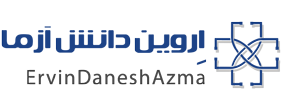
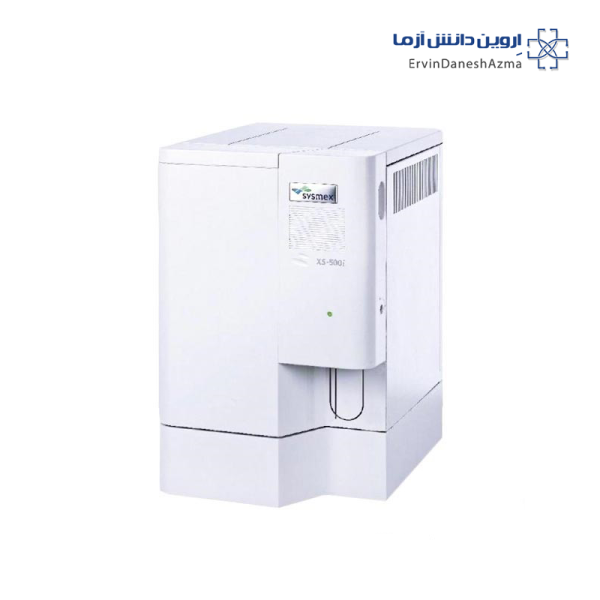

 مشاوره رایگان
مشاوره رایگان ارسال فوری
ارسال فوری

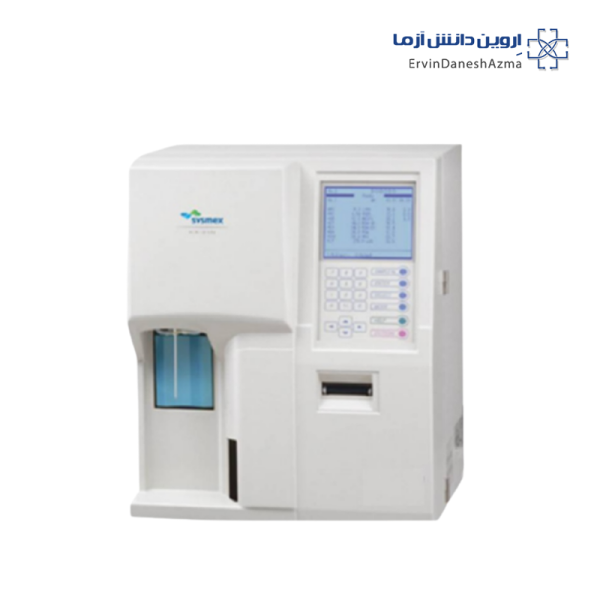

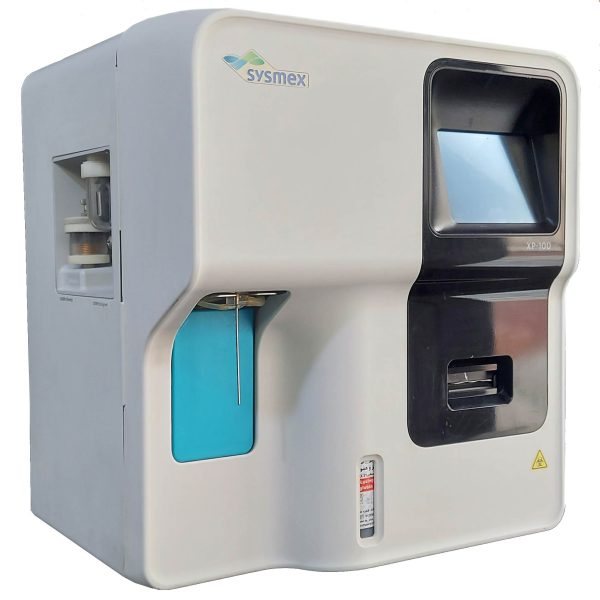
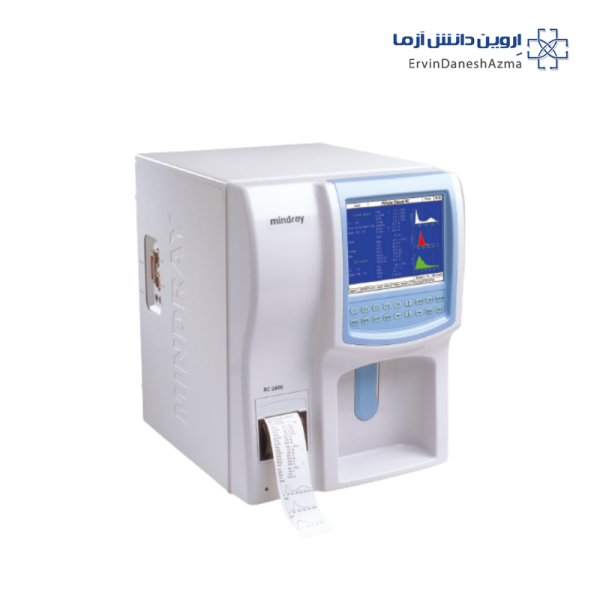
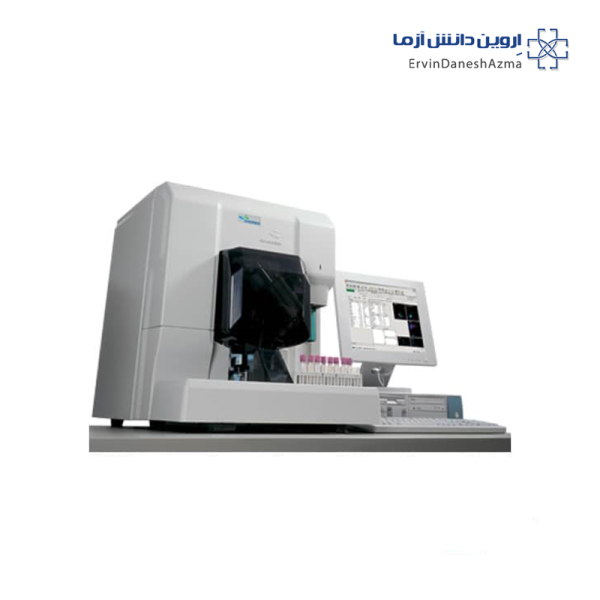
نقد و بررسیها
هنوز بررسیای ثبت نشده است.